SUPERCHARGE YOUR ONLINE VISIBILITY! CONTACT US AND LET’S ACHIEVE EXCELLENCE TOGETHER!
What is image EXIF data?
Image EXIF data (Exchangeable Image File Format) is metadata embedded within a digital graphic file. EXIF data provides additional information about the image, such as camera settings, date and time of capture, camera model, exposure settings, focal length, GPS coordinates, which website image belongs to and much more. Optimised data, such as accurate titles, descriptions, and geolocation information, can enhance the user experience. When users find relevant and informative images with appropriate metadata, they are more likely to engage with the content, stay on the webpage longer, and potentially share the images on social media or other platforms. It can improve the chances of the images appearing in search results. This can drive traffic to the website hosting the images and potentially enhance overall SEO.
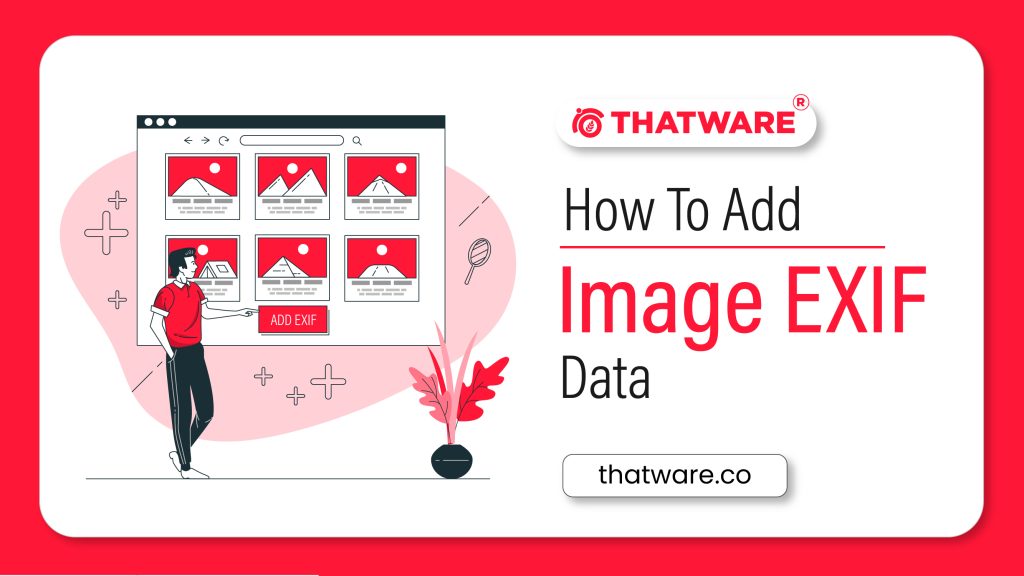
How to Add EXIF Data on an Image
1) Go to a website https://www.thexifer.net/
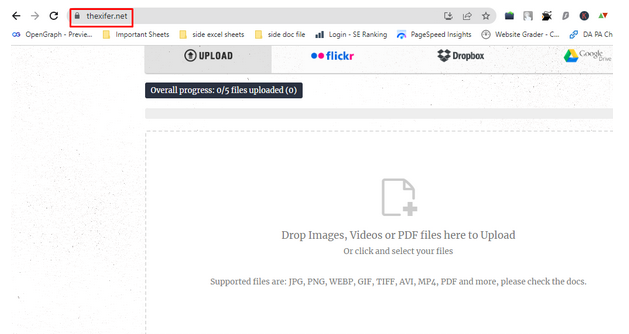
2) Upload an image
Upload an image on https://www.thexifer.net/ and after uploading, go to exif.me option
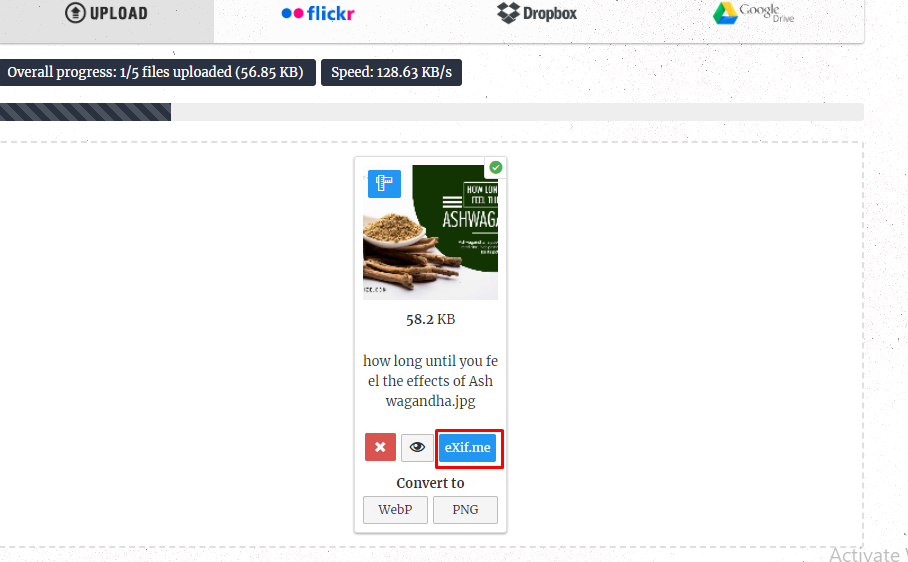
3) Enter The Important Informations
Atfirst go to “EXIF General” option to put data about the website the image belongs to
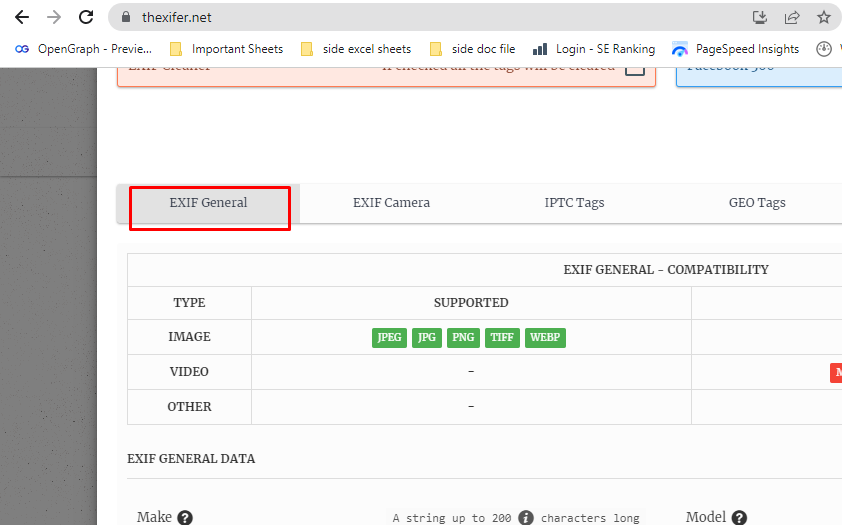
Then put the website and image information in the following places
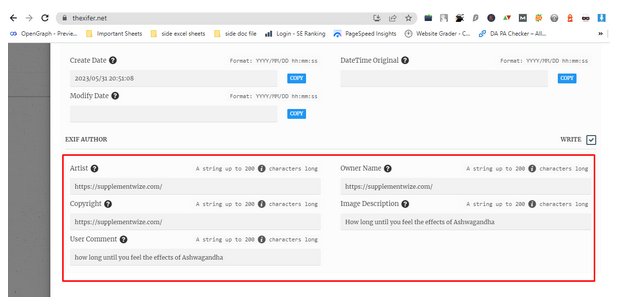
4) Add Geotag To The Image
Then Go to the “GeoTag” Option to put the Geotag of the Website. Geo Tag data can be taken from website source code

This following Latitude and Longitude will be use as image Geo tag
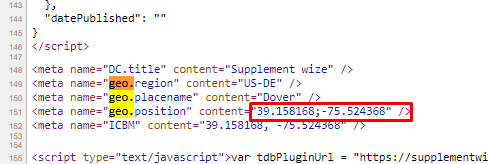
Put the geotag in the following places and then click the “Set Map” option
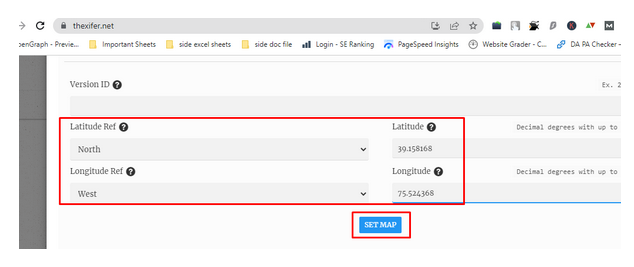
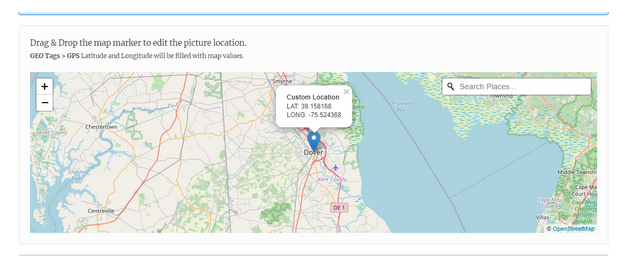
5) Add Title And Description To The Image
Go to “XMP Tags” Option to put title and description of the page where the image belongs to
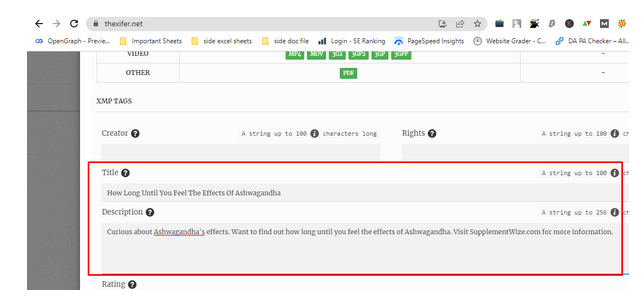
6) Download The Image and Re-upload It
Scroll Down and go to “ GO EXIFING” option and the image will be download with EXIF data.
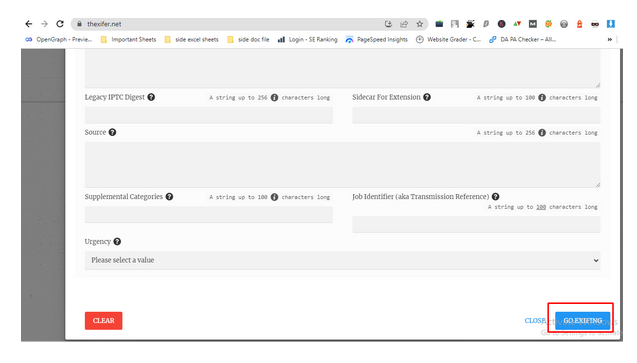
Then go to “download me” option and the image will download with EXIF data
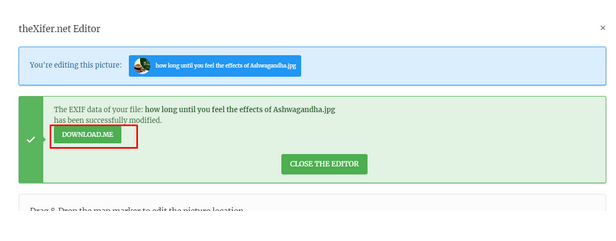
Then the image needs to re-upload on the website.
Why It is Important to Add IMAGE EXIF DATA?
Adding EXIF data to your images is an important practice that offers several benefits, including enhancing SEO, improving user experience, and protecting your intellectual property. Here are the key reasons why adding EXIF data is important:
1. Improves Image Search Rankings:
Properly tagged images with relevant EXIF data, such as titles, descriptions, and keywords, increase the chances of appearing in image search results. Search engines can better index images based on their content and context, making them more discoverable to users.
2. Enhances User Experience:
Informative EXIF data helps users understand the context and relevance of an image. Details such as camera settings, capture date, and location enrich the user experience by providing insight into the image’s background and origin.
3. Boosts Local SEO:
Geotagging images with latitude and longitude coordinates can improve your website’s local SEO. When users search for images in specific locations, geotagged images are more likely to appear in search results, increasing the visibility of your content.
4. Protects Intellectual Property:
Adding copyright and licensing information in EXIF data establishes your ownership of the images and provides clarity on usage rights. This can help deter unauthorized use of your images and support legal claims if necessary.
5. Supports Image Attribution:
By including metadata such as the photographer’s name and the source of the image, you facilitate proper attribution when the image is shared or published elsewhere. This helps maintain the integrity and reputation of your work.
6. Facilitates Image Management:
EXIF data serves as a valuable tool for organizing and managing your image library. Information such as capture date, camera settings, and geolocation can help you sort and categorize images efficiently.
7. Enhances Accessibility:
Providing detailed descriptions and alt text in the EXIF data improves accessibility for visually impaired users. These elements describe the image’s content and context, allowing all users to understand and engage with the content.
8. Supports Image Optimization:
Adding metadata such as titles, descriptions, and keywords helps optimize your images for search engines. This optimization can lead to higher visibility, increased traffic, and more user engagement.
9. Increases Content Relevance:
Images with detailed EXIF data can be better matched to user search queries, making your content more relevant and engaging for users. This can enhance the overall quality of your website’s content.
10. Fosters Trust and Credibility:
High-quality images with accurate and informative EXIF data help build trust and credibility with users. When users find relevant, well-tagged images, they are more likely to view your content as authoritative and reliable.
Adding EXIF data to your images is a crucial step in optimizing your content for search engines, improving user experience, and protecting your intellectual property. By leveraging the benefits of EXIF data, you can enhance the overall quality and effectiveness of your website’s visual content.
Importance from an SEO Perspective
- Improved Image Search Rankings:
Properly tagged images with relevant keywords and descriptions are essential for improved image search rankings. By including relevant terms in the image’s title, description, and tags, search engines can better understand and index the image based on its content and context. Incorporating specific keywords related to the image’s subject, location, or theme increases its visibility in search engine results pages (SERPs). Additionally, metadata should be descriptive, unique, and pertinent to the image and the associated webpage content. Including the image’s alt text, which describes the image for accessibility, is also crucial for optimizing search engine ranking.
- Enhanced User Experience:
Informative and context-rich EXIF data helps users understand the image’s context and relevance. Providing details such as camera settings, capture date, and location can enrich the user experience and add credibility to your images. Contextual information allows users to engage more deeply with your content, fostering a stronger connection and understanding of your message. Alt text and descriptive metadata enhance accessibility for users with visual impairments, allowing them to understand the image’s subject. By offering comprehensive information about your images, you can captivate and retain users, resulting in a more satisfying and enriching experience on your website.
- Greater Visibility:
Geotagging images can significantly improve local SEO and increase the visibility of your website in location-based searches. By attaching latitude and longitude coordinates to your images, you enable search engines and users to locate where the image was captured or its context. This added geographical data can enhance your images’ relevance in location-based search queries and improve the chances of appearing in local image searches. Geotagging is particularly important for businesses or websites that cater to specific locations, as it helps users find content relevant to their area. When paired with well-optimized metadata, geotagging can significantly enhance your website’s local search presence.
- Boosted Engagement:
High-quality images with meaningful metadata can engage users and encourage them to share your content. When images are optimized with context-rich descriptions and keywords, they become more appealing and accessible to users, resulting in increased interest and interaction. Eye-catching images that resonate with users’ interests or needs can boost engagement rates and lead to more shares across social media platforms. This, in turn, expands the reach of your content and introduces your website to new audiences. Additionally, images with useful metadata can foster trust and credibility among users, leading to a stronger connection with your brand and content.
- Increased Website Traffic:
Optimized images can drive traffic to your website through image search and related content links. By incorporating relevant keywords and descriptive metadata, your images are more likely to appear in image searches, which can result in more clicks and visits to your website. Additionally, well-optimized images on your website can be linked to related content, encouraging users to explore further and spend more time on your site. This increased traffic can lead to higher engagement, improved conversion rates, and ultimately, greater success for your website or business. By taking the time to optimize your images with EXIF data and metadata, you create more opportunities for users to discover your website and interact with your content.
By following these steps and focusing on SEO, you can enhance the visibility and impact of your images online.
Maximize Your Digital Presence: The Importance of Adding EXIF Data to Your Images
Adding EXIF data to your images is a crucial step in optimizing your content for search engines, improving user experience, and protecting your intellectual property. By leveraging the benefits of EXIF data, such as properly tagging images with relevant keywords and geotagging, you can enhance the overall quality and effectiveness of your website’s visual content. Additionally, context-rich metadata can increase your content’s relevance and foster trust and credibility with users. By following the outlined steps and focusing on SEO, you can amplify your images’ visibility and impact online, resulting in increased engagement and traffic to your website. Prioritize EXIF data for a more successful digital presence.
Mastering Image EXIF Data for Next-Gen SEO and Digital Asset Intelligence
In today’s competitive digital landscape, visuals do more than beautify a website—they power discoverability, reinforce branding, and shape user trust. But there’s an invisible layer baked into every image that most businesses ignore: EXIF metadata. Short for Exchangeable Image File Format, EXIF data provides hidden insights that can be strategically used to improve SEO, boost image ranking, verify content credibility, and streamline asset management.
At ThatWare, we don’t just optimise images—we enhance the intelligence they carry. Our proprietary systems extract, enrich, and deploy EXIF data to strengthen visibility, boost rankings, and ensure every digital asset works harder.
What is EXIF Data and Why Does It Matter in 2025?
EXIF data refers to metadata automatically recorded by digital devices like cameras, smartphones, and image editing tools. This metadata typically includes:
- Date and time of capture
- GPS coordinates (latitude, longitude, and altitude)
- Device make and model
- Exposure settings (aperture, ISO, shutter speed)
- Editing software and export parameters
- Copyright and author fields
While it may appear technical or even trivial, EXIF data is a silent carrier of context. In the era of AI and semantic search, context is what sets apart high-performing content from the mediocre.
SEO Benefits of EXIF Optimisation
Improved Image Search Discoverability
When images are embedded with well-structured metadata—like a title, description, and location—search engines can better categorise and index them. That translates into higher visibility in Google Images and visual search tools.
For instance, embedding the keyword “Eiffel Tower drone shot 2023” into the EXIF title field makes that image more relevant and specific to user queries with location and intent.
Local SEO Boost via Geotagging
Local businesses can leverage GPS data within EXIF to enhance their geo-relevance. If a restaurant in Delhi uploads geotagged food photos, Google can associate their brand with Delhi-based searches like “best biryani near me.”
Content Authenticity for E-E-A-T
Google values trustworthy content. Time-stamped, location-tagged images with clear author tags reinforce Experience and Trustworthiness—especially useful for journalists, reviewers, or legal firms.
Better Ranking for Time-Sensitive Content
Images that include accurate timestamps and dates can help news sites, blogs, and e-commerce stores align content with freshness signals. This is especially critical for industries like fashion, finance, or seasonal tourism.
ThatWare’s EXIF Optimisation Workflow
Image Library Audit
We begin by scanning your existing images for missing, outdated, or inconsistent EXIF fields. Our tools identify gaps in timestamps, geolocation, author names, or descriptive tags.
AI-Driven Metadata Enrichment
Our proprietary AI fills in missing metadata intelligently, guessing location based on visual analysis or adding author data based on publishing history. We ensure all fields are complete, accurate, and strategically aligned.
Brand Protection Layer
We inject copyright statements, usage terms, and custom branding into EXIF data, discouraging content theft while aiding in copyright enforcement.
Metadata Structuring & Export
Images are processed and exported in SEO-ready formats—optimised not just for file size but for context. We support EXIF integration across JPG, PNG, and even TIFF formats, ensuring metadata survives platform changes.
Compliance and Privacy Filtering
Before deployment, we clean sensitive metadata such as personal location data or private notes, ensuring GDPR, CCPA, and internal compliance standards are upheld.
EXIF Use Cases Across Industries
Real Estate
Photos of properties are embedded with GPS and time data to ensure authenticity and improve local search performance.
E-Commerce
Original product photos get tagged with descriptive titles, brand info, and licensing metadata. This helps reduce image theft and supports product-specific Google image results.
Travel & Tourism
Geotagged destination photos boost visibility in regional image searches like “hidden beaches in Bali” or “best sunrise spots in Rishikesh.”
News Media
For journalists and publishers, timestamped and author-embedded images support source credibility and content traceability.
Design & Photography
Artists embed author data, copyright terms, and creative descriptions directly into images, turning every photo into a branded digital footprint.
Challenges with EXIF Data and How ThatWare Solves Them
Metadata Stripping on Social Platforms
Instagram, Facebook, and Twitter often strip EXIF data upon upload, making it difficult to track images once shared.
ThatWare’s Solution: We maintain original metadata in the backend CMS versions while providing watermarked versions for social platforms.
Inconsistent Timestamps and Location Data
Images taken from different devices or edited in various software may have conflicting timestamps or geolocation gaps.
ThatWare’s Solution: We normalise timestamps using server data and approximate missing locations using AI tagging.
Privacy Concerns
Sometimes, images captured by staff or clients may contain sensitive location or device data.
ThatWare’s Solution: Our system flags sensitive EXIF fields for redaction before public deployment, ensuring data protection without sacrificing SEO value.
How Visual Search Is Reimagining Metadata Value
With tools like Google Lens, Bing Visual Search, and Pinterest AI, EXIF data now informs how platforms understand and rank visual content.
- AI uses GPS tags to validate image location
- Date stamps help prioritise recent content
- Device data helps determine image quality
- Copyright and author metadata build trust with both users and bots
ThatWare ensures your images are not only visually appealing—but also AI-readable and search-ready.
Pro Tips for EXIF Optimisation
- Use keyword-rich EXIF titles: Instead of “IMG_4567”, use “organic-handmade-clay-vase-london”.
- Always include copyright & brand name in the author field.
- Add precise GPS data if location matters to your content strategy.
- Avoid overloading EXIF with irrelevant or duplicate info.
- Batch edit using ThatWare tools for speed and consistency.
- Test image results with and without EXIF to measure the impact.
- Retain metadata through compression—don’t let CDNs strip it.
Client Case Study: Boosting Product Visibility with EXIF
A multi-brand fashion retailer approached ThatWare after struggling to gain traction in Google Image Search. We:
- Re-tagged 3,000+ product images with EXIF descriptions, category keywords, and brand metadata
- Added GPS data for localised campaigns
- Inserted author tags referencing specific brand lines
Results in 45 Days:
- 270% increase in image impressions
- 58% growth in CTR from Google Images
- Reduced bounce rate from visual traffic by 34%
What Makes ThatWare’s EXIF SEO Different?
While many agencies stop at alt tags, ThatWare engineers metadata on a deeper semantic level. We integrate EXIF data with:
- Custom schema markups
- AI-led image analysis tools
- Visual relevance scoring
- Real-time monitoring dashboards
- Metadata compliance filters for sensitive industries
Our Hyper Intelligence SEO platform turns every image into a structured, optimised, traceable asset.
The Future of Image Metadata and AI Integration
As AI evolves, so does its hunger for context. Image metadata—especially EXIF—will feed next-generation models that:
- Build real-time scene recognition
- Deliver hyper-personalised visual search
- Enable ethical content sourcing through origin tags
- Score images based on device authenticity and timestamp patterns
ThatWare is already building this future, ensuring your brand’s images are not only optimised for today’s SEO but prepped for tomorrow’s AI-driven discovery engines.
Image EXIF Data in Compliance and Digital Forensics
In today’s regulatory environment, organisations must prioritise not only marketing performance but also content compliance, evidence preservation, and digital traceability. This is where EXIF metadata steps beyond SEO and enters the realm of legal, operational, and forensic significance.
Regulatory Compliance and Metadata Standards
Industries such as healthcare, finance, government, and legal services are bound by strict regulations around data transparency and media documentation. EXIF metadata can serve as:
- Proof of content origin: Timestamped, author-tagged images establish when and by whom content was created.
- Evidence of authenticity: Helps confirm image integrity in audits, investigations, or IP disputes.
- Archival consistency: Maintains a structured record of media usage over time, which is crucial for long-term archiving and compliance.
At ThatWare, we tailor EXIF workflows to match specific compliance frameworks (e.g., HIPAA, GDPR, ISO 27001) and ensure that metadata contributes to secure and lawful content management.
Forensic Value of EXIF in Digital Investigations
Digital forensics professionals regularly analyse EXIF data to reconstruct timelines, determine geolocation relevance, or identify tampering. For organisations operating in sensitive sectors—journalism, law enforcement, insurance—preserved metadata can be the digital fingerprint that validates the credibility of visual evidence.
ThatWare’s systems include automated metadata hashing, archiving, and monitoring tools to help enterprises retain the original EXIF layers of their assets, even after editing, compression, or migration.
Whether you’re preparing for a brand audit, defending an IP claim, or structuring compliant media workflows, EXIF metadata becomes an anchor of digital truth. It’s not just data—it’s your digital trail of trust, transparency, and traceability.
Conclusion: From Invisible Data to Measurable Results
EXIF metadata may be hidden, but its impact is massive. From SEO to brand protection, visual search to content credibility—it acts as a foundational signal in how digital images are understood and ranked.
At ThatWare, we don’t just optimise visuals—we engineer the data beneath them. Let us help you turn every image into a search-powered asset with AI-augmented metadata strategies.
Ready to Optimise Your Image Library?
Request a free EXIF SEO audit today and see how ThatWare’s advanced solutions can turn invisible metadata into visible growth.

